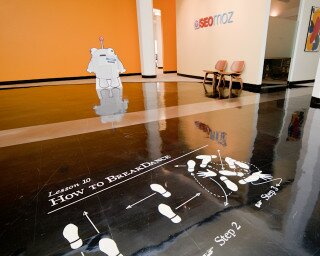One of the icons of the Industrial Age is the time clock (aka punch clock – maybe because you’re very tempted to punch it).
In my youth I had a factory job where life was ruled by that clock. In a rack on the wall by the clock were punch cards for each employee. When you arrived for your shift, you inserted your card in the machine, and it stamped the time you began work.
At the end of a shift, there would always be some guy with a card already in the slot, just as far as it would go without getting stamped, so at the exact moment the clock ticked over to the top of the hour, he could tip the card that last millimeter, get his stamp, and race for the parking lot.
The Clock was our Lord and Master.
The Clock and Industrial Efficiency
In a very real sense, the Industrial Age could not have happened without the time clock. Industrialism is dependent on replaceable, interchangeable parts, both product parts and human resources. Think about that last term: human resources. Resources are mined out of the ground or taken off a shelf. If one fails or disappears, there are plenty more to take its place.
In an industrial age business, the human resources are plugged into jobs that are in most cases boring, anti-creative, non-stimulating. To keep people at such drudgery, two tools are employed: hourly wages and the time clock.
The hourly wage incentivizes one thing and one thing only: putting in the required number of hours of “doing the work.” The time clock is the enforcement mechanism necessary to accomplish that goal.
Amazingly, this system has worked very well for what it was designed to do: churn out the one-size-fits-all but highly dependable products that fueled the consumer revolution, the rise of the middle class, standardization-enabled mass growth, and (seemingly) ever-inflating GNPs.
But the cost side of that equation was two-fold.
For one thing, industrial efficiency stunts human creativity. Hourly workers ruled by the clock have little to no incentive to innovate (other than coming up with creative ways to be first at the time clock at work’s end).
But the other cost has been more grim: the toll on the human spirit. In stead of work which is human creativity birthing new things into the world, most people just have jobs, something you spend a set number of hours just “doing” to earn your pay.
The Industrial Age is about finite games, where it’s all about an ending where someone wins, and everyone else has to lose a little to get to the goal of the game.
Killing the Clock
In a previous post here I discussed how we’re in a time of transition from the industrial economy to the connected economy. The connected economy, where because of the Internet and other technologies work can be trans-local, collaborative, and independent of institutions. should be antithetical to clock rulership.
Yet many businesses that seem primed for the connected economy, businesses whose main product is ideas, remain chained to the industrial age clock mentality. They still pay by the hour and expect employees to show up at a certain time and remain a certain number of hours at the workplace. They say, “You will be creative and innovative and collaborative….when we say you will.”
But not all connected age businesses remain anchored in the old paradigm. I’ve been intrigued and encouraged by at least two examples I’ve run across of businesses who have successfully killed the clock.
Moz: The Sleep-in CEO
 Rand Fishkin is the CEO of Moz (formerly SEOMoz), one of the best known and most respected companies in the SEO/online marketing industry. Their transition from being a client-serving agency to a software and services provider put them in serious need of a large number of skilled engineers and technicians. But they’re located in Seattle, where there is very high demand for such workers, and therefore salary inflation.
Rand Fishkin is the CEO of Moz (formerly SEOMoz), one of the best known and most respected companies in the SEO/online marketing industry. Their transition from being a client-serving agency to a software and services provider put them in serious need of a large number of skilled engineers and technicians. But they’re located in Seattle, where there is very high demand for such workers, and therefore salary inflation.
Trying to create a lean and agile startup, Rand wanted to pay as well as possible, but knew he wouldn’t be able to compete on just salary with the many tech giants in his city. So he set out to create a company that competes with its culture.
In a post on his personal blog today, Rand inadvertently clued me in to part of that culture that is able to attract some of Seattle’s most talented people for less than they might make elsewhere.
In response to a question from a fellow CEO, Rand wrote a detailed description of how he manages to stay active on social media despite the constant demands of running Moz. As part of his explanation, he posted a timeline depicting an “average” workday for himself:

Obviously Rand is a night owl. But what struck me was seeing that he doesn’t typically arrive at his office until 11 am. Sounds pretty lax for a CEO!
I suspected that Rand was an advocate of flexible work schedules, so I messaged him on Google+ to ask about that, and got back the following response:

“The work is what matters, not where you do it.” (Or when, for that matter, judging by the “we hate measuring on face time” comment.)
Moz has succeeded in killing the clock. Ok, that’s a bit hyperbolic. They haven’t “killed” the clock. As Rand said, they do schedule times for meetings and team collaboration. But the essential difference here is that those set times are arrived at collaboratively and because they make sense for getting the work done, not because the clock says it’s time to have a meeting.
There is another essential but unspoken element here: trust.
It seems clear that a CEO who can publicly state he “hates measuring face time” has enormous trust in his employees. When he says “the work is what matters,” he means that there is a different incentive at Moz than putting in your required time. Knowing what I know of Rand and his company, I’m confident what is rewarded is real human work: creativity, ingenuity, innovation, team-building, etc.
Trust becomes more than a company motto when it is accompanied by real empowerment. The core values of Moz are encapsulated in a company code expressed in an acronym: TAGFEE. TAGFEE stands for the following values:
- Transparent
- Authentic
- Generous
- Fun
- Empathetic
- Exceptional
Building a culture like that doesn’t come easily, and Rand has made his mistakes (he lives out Transparency by blogging about his failures as well as his triumphs). But Rand and Moz have fought hard to make trusting employees a reality, and have taken big strides to end the tyranny of the clock. And gained a highly agile, productive, and creative work force as their reward.
Hubspot: Creating a Culture We Love
Another company that has been on a mission to bring down the tyranny of the clock with that champion clock-killer. trust, is online marketing company Hubspot.
Hubspot woke up early to the reality of the connected economy. They realized that the emerging generation of workers didn’t necessarily value what their parents had. Putting in the years to get a gold watch and a reasonable pension no longer had any pull. this new generation knows they have options, even in challenging economic times. And Hubspot knew that all companies have cultures. They asked, “Why not create one we love?’
Rather than write out the details here, I invite you to view this inspiring and entertaining slide deck Hubspot created that describes the culture they strive for:
Timeclock Photo Credit: ChrisM70 via Compfight cc


Well said Mark. This is the way we run our company and I would never go back to 9-5 requirements. It feels really unproductive to base non-production work on hours rather than goals/projects. The flip side of trust is ownership. By giving folks the freedom, I am also giving them the responsibility. And if we’ve done our job and hired people who fit our culture, once they feel ownership, there’s no longer any need to quibble about hours.